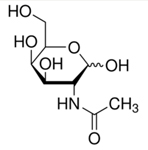|
N-acetylgalactosamine is the least known of the eight essential sugars. As with the others, this one is also important for proper cell-to-cell communication. This communication is important for both normal systemic function and in such disease processes as cancer, inflammation, and immunity.
Absorption
It appears that N-acetylgalactosamine is absorbed from the intestines by a specific transporter, but more research needs to be done on this. As it stands now, there appears to be a specific transporter for this saccharide that differs from that used by Glucose. Researchers are just beginning to realize the existence of specific intestinal cell transporters for all the different essential sugars.
Excretion
There is little specific data available, but it appears that N-acetylgalactosamine is excreted in much the same way as the other glyconutrients; that is, in the urine, since a specific enzyme for this saccharide is located in the kidney and could be used for recycling the sugar. Studies indicate that most of an oral dose would be eliminated from the bloodstream after 8-12 hours.
Functions
-
As an essential sugar, the role is essentially the same for N-acetylgalactosamine as it is for the others, which is to enhance cellular communication. This stands to reason since a breakdown in human communications always results in misunderstandings which often escalate into large and small wars, so it is with cellular communication. When it breaks down, caos escalates into disease. Studies have confirmed that levels of N-acetylgalactosamine are altered in certain diseases, suggesting that it plays an important role in the prevention of those diseases.
-
Although there has not been much research to date, what has been done reveals that this saccharide may inhibit the growth of some tumors. For example, colon cancer patients have only half the normal amounts of N-acetylgalactosamine. Studies have shown that colon cancer cells that metastasize make more mucin, making them more likely to form metastases. Therefore, it appears that N-acetylgalactosamine plays an important role in preventing this formation from occurring.
-
Lower than normal levels of this sugar have been found in patients with heart disease implying that these conditions may be reversed if a supplementation of N-acetylgalactosamine were to be added to the diet.
-
It appears that this sugar plays a role in joint function, sweeping away destructive free radicals that can cause inflammation.
-
N-acetylgalactosamine also seems to play an important role in the immune system. Contained in macrophages and neutrophils, it may play a significant role in the etiolology of joint inflammation and could be important in such conditions as rheumatoid arthritis.
-
N-acetylgalactosamine is localized in the golgi apparatus and endoplasmic reticulum ?found in cell organelles and associated with synthesis of various proteins and enzymes.
-
Since it is also found on the surface of cortical neurons and involved in synaptic function of the brain, this suggests that it may be important in nerve function.
-
N-acetylgalactosamine is also concentrated in other sensory nerve structures especially in the retina, photoreceptors, optic nerve, and the epithelial pigment of the eyes of both humans and animals. This suggests that it may be extremely important for optimal vision.
-
N-acetylgalactosamine is distributed to several other tissues, suggesting that it is important in the functional role of these tissues. Some of these tissues include the ducts of the kidney, the testes, the skin, and a variety of other structures including sweat glands, some blood vessel cells, and hair follicles.
-
It is known that concentrations of N-acetylgalactosamine decrease with age, implying that age-deterioration of various body functions could be held off with the addition of this saccharide to the diet.
Safety
Since research is fairly new for this particular sugar, little is known for sure. During lab experiments, exceptionally high doses are used. Therefore, to equate a safe dose for humans at this time is pure speculation. What is known is that when extremely high doses of N-acetylgalactosamine are given to experimental animals, a type of hepatitis is created. It is speculated that as much as 280 mg. twice a day would be safe for a healthy 150-pound adult. Information is not available as to a minimum amount. As with other essential sugars, whatever amount is taken should be divided into two daily doses to keep blood levels fairly constant.
Dietary Sources
-
There is an abundance of N-acetylgalactosamine found in Bovine and Shark cartilages. However, Shark cartilage should not be consumed by those with diabetes or kidney disease.
-
It is also found in a red algae called Dumontiaceae, as a constituent of dextran sulphate; but, so far, this is available only from Japan.
-
Although Shiitake mushrooms contain N-acetylglucosamine, they do NOT contain N-acetylgalactosamine.
-
N-acetylgalactosamine is also constituent of Chondroitin sulfate, a useful sugar but not essential, which is often combined with Glucosamine in the treatment of osteoarthritis. When Chondroitin sulfate is used with Glucosamine sulfate, the absorption rates of both is dramatically increased
|
